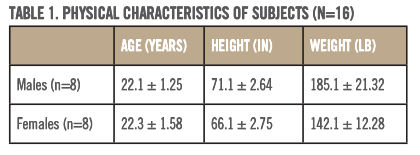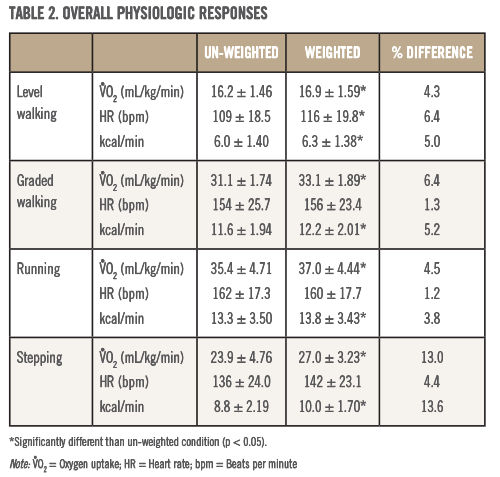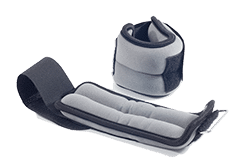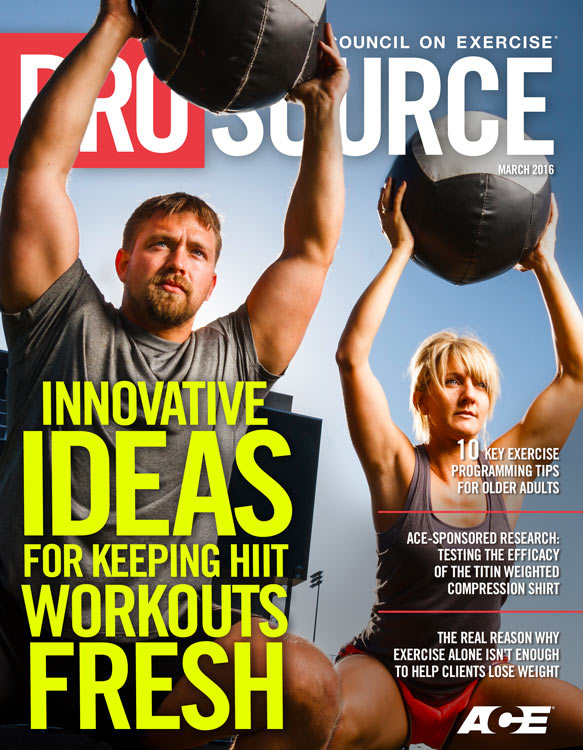
The ongoing quest of athletes and fitness enthusiasts to achieve maximal benefits from their exercise programs continues with the development of the TITIN Force™ Shirt System, which consists of a 14-pocket inner compression shirt that holds weighted hydro-gel inserts and an outer compression shirt to hold everything in place (http://titintech.com). When all of the inserts are used, the total weight of the shirt used in the research is 8 pounds (3.6 kg) and costs $249.95, though there is a 20 pounds (9.1 kg) version available on the TITIN website for $350.
The company claims that wearing the compression shirt system will lead to a 7 percent increase in caloric expenditure. ACE enlisted the help of John Porcari, Ph.D., and his team of researchers in the Department of Exercise Sport Science at the University of Wisconsin–La Crosse to test this claim.
The Study
For this study, the researchers recruited 16 apparently healthy, college-aged volunteers (Table 1). All subjects were regular exercisers who worked out at least 150 minutes each week. It is important to note that the weighted compression shirt weighed approximately 4.9 percent of the average body weight of the subjects.
Each participant completed two testing sessions consisting of four different exercise activities, each for a duration of five minutes:
- Walking at 3.5 miles per hour (mph)
- Walking at 3.5 mph at a 10 percent grade
- Running at a self-selected pace
- Stepping up and down on a 12-inch bench at a rate of 24 steps per minute
During the first session, the subjects completed the activities in random order while wearing either the TITIN weighted compression shirt or a compression shirt without weights. On the second day, they completed the exercises in the same order, but wore the opposite compression gear. Workloads for each activity were held constant, so that the additional weight carried in the TITIN weighted compression shirt was the only variable responsible for potential differences in energy expenditure.
During both workouts, researchers measured heart rate each minute, continuously measured oxygen uptake (VO2) and calculated caloric expenditure from the VO2 data.

The Results
The physiological responses for all four exercise bouts are presented in Table 2.

Observational Notes
While ratings of perceived exertion were not collected as part of this research, Kelly Hoppe, the lead author of this study, did offer some observational notes. “The majority of the subjects claimed that working out with the TITIN shirt was harder and, when asked what modality was hardest when wearing the weighted shirt, walking at a 10 percent incline was the most popular choice.” Subjects also noted excessive sweating when wearing the TITIN shirt: “Subjects noted how much more they perspired during their workouts with the TITIN shirt on, and they seemed to gauge how hard they worked based on the amount of sweat.”
Caloric expenditure and VO2 were significantly higher when wearing the TITIN weighted compression shirt compared to the un-weighted condition across all four types of exercise. The increase in VO2 values ranged from 0.7 mL/kg/min during level walking to 3.1 mL/kg/min during the stepping exercise. Calculations of caloric expenditure yielded a similar trend; the increase ranged from 0.3 kcal/min during level walking to 1.2 kcal/min during stepping. When the results from all four exercises were combined, the average increase in VO2 and caloric expenditure from the un-weighted to the weighted condition was 7 percent.
The Bottom Line
Stated simply, the results of this study were identical to the claims made by the company—wearing the 8-pound TITIN weighted compression shirt system led to a 7 percent increase in caloric expenditure.

Wrist and Ankle Weights
Increasing the energy cost of an activity through the addition of weight to the hands, wrists and ankles has long been popular in gyms and training facilities, and this practice has been widely studied. Multiple studies have found that there is an increase in heart rate, VO2 and energy expenditure when wearing wrist or ankle weights (Claremont and Hall, 1988; Graves et al., 1988; Martin, 1985). The weights used in these studies ranged from 1 to 3 pounds (0.5 to 1.4 kg), and the increases in heart rate and VO2 climbed as high as 9 percent and 14 percent, respectively.
Adding weight to the extremities increases the intensity of movement by making the lever arms less efficient, explains Dr. Porcari. While this certainly makes movement more difficult and drives an increase in energy expenditure, it also adds strain to the elbow and shoulder joints and creates greater impact forces. The disruption in biomechanics also adds to the risk for potential injury.
To minimize the injury risk, Dr. Porcari says that exercisers should never use weights heavier than 2 pounds (0.9 kg) on their extremities, and should never run while wearing ankle weights.
Weighted compressions shirts or vests, in contrast, hold the additional load tight to the core, making them a safer choice. In addition, adding weight in the form of a compression shirt allows freedom of the hands and wrists during exercise, which means they can be worn during a wide variety of fitness-related activities.
The researchers concluded that wearing the TITIN Force Shirt System may be beneficial for individuals who are looking to increase the intensity of their current exercise programs and burn more calories. “Because the use of a weighted compression shirt means that the load carriage is close to the core,” explains Dr. Porcari, “changes in caloric expenditure are relatively modest. But that modest 7 percent increase can be very beneficial, particularly for individuals who perform certain types of exercise in which they are working against gravity.” To derive more significant increases in energy expenditure, Dr. Porcari notes, one would have to carry much more weight, which is potentially unsafe.
Note that the greatest effect of the TITIN shirt was seen during the stepping exercise, which required the subjects to lift the additional weight against the force of gravity. From the un-weighted to the weighted condition, there was a 13 percent increase in VO2 and a 13.6 percent increase in caloric expenditure. Athletes in sports that require climbing or jumping may see the greatest benefit from using this product.
Perhaps the most important element of this research is the fact that the company’s claims are modest and realistic, and were substantiated by research. This is in stark contrast to the outrageous claims sometimes made in the fitness industry that often negatively impact the reputation of the industry and its professionals. Other equipment manufacturers and program developers would be wise to follow the example of TITIN by making modest, research-supported claims that allow consumers to make educated decisions and that add to the credibility of the fitness industry.
References
Claremont A.D. and Hall S.J. (1988). Effects of extremity loading upon energy expenditure and running mechanics. Medicine and Science in Sports and Exercise, 20, 167–171.
Graves J.E. et al. (1988). Physiological responses to walking with hand weights, wrist weights, and ankle weights. Medicine and Science in Sports and Exercise, 20, 265–270.
Martin, P.E. (1985). Mechanical and physiological responses to lower extremity loading during running. Medicine and Science in Sports and Exercise, 17, 427–433.












